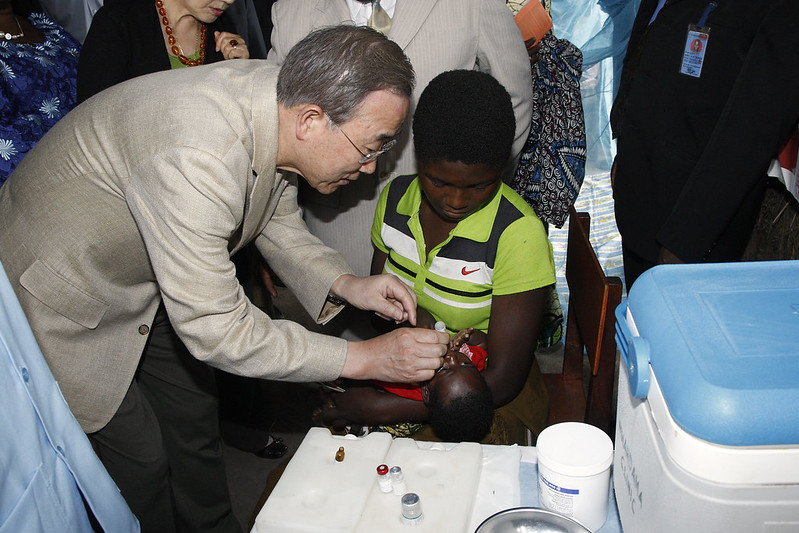Image Credit: United Nations Photo. CC-BY-NC-ND.
A 3-year-old in Malawi has the first case of wild-type poliovirus in Africa in 5 years, and the first in Malawi in over 30 years. She has been paralyzed since November 19, 2021, at which time testing designated her disease as vaccine-derived polio. However, it was determined in February 2022 to be wild-type polio derived from a family of viruses circulating in Pakistan in October 2019.1
It is currently unknown how the disease traveled to Malawi over the 25 months between the outbreak in Pakistan and the 3-year-old’s disease onset in November. However, the path of infection is now a topic of great interest to infectious disease experts. Other children in Malawi and neighboring countries may have been infected through the spread of this disease, and emergency vaccination campaigns may now be necessary to prevent a larger outbreak. As Derek Ehrhardt, acting branch chief for polio eradication at the Centers for Disease Control and Prevention, put it, “The virus is there. We need to respond to it in a robust way.”2
In response to this new case, Malawi and neighboring countries are closely monitoring the situation and strengthening vaccination against polio. Vaccination campaigns that aim to interrupt person-to-person transmission of the virus use Oral Polio Vaccines (OPVs). These vaccines are very effective at reducing transmission and are cheap and easy to distribute as they don’t require medical professionals or syringes. However, when there is insufficient vaccination coverage in a community over time, OPVs can cause the spread of vaccine-derived poliovirus.3 In fact, there were 620 cases of vaccine-derived polio recorded in 2021 compared to only 5 wild-type cases, which is why the discovery of the Malawian case as wild-type polio was so concerning.4 While oral polio vaccination is needed to prevent the spread of wild-type polio, vaccination campaigns must prioritize thorough coverage to reduce the risk of vaccine-derived poliovirus.
The potential spread of wild-type poliovirus in Africa also has larger implications for the global eradication of polio. Previously, Pakistan and Afghanistan were the only countries still endemic for wild-type polio and had been making great strides against the virus. In fact, in January 2022 Pakistan celebrated its first full year with no recorded polio cases.5 Since the newly discovered case in Malawi is considered an imported case from Pakistan, Africa still maintains its status as wild-type poliovirus free.6 However, if spread did occur, and more cases are diagnosed, the status may be impacted.
Whether related to this case or not, it’s possible that more cases of poliovirus will be discovered in the coming months. While 2021 saw record low levels of poliovirus transmission, it is likely that the COVID-19 pandemic impacted both polio surveillance and vaccination, both of which may have lasting implications for polio eradication.7,8 In March of 2020, the Global Polio Eradication Initiative (GPEI) suspended supplementary polio vaccination programs due to COVID-19, and the programs did not resume until November 2020.9 While the GPEI recommended the continued surveillance of polio symptoms through 2020, namely acute flaccid paralysis (AFP), the number of reported AFP cases declined by 33% in 2020.10 While programs have since adapted to the challenges of COVID-19, it is unclear what the long-term impacts of these setbacks will be. Unfortunately, other infectious diseases that also had surveillance and treatment impacted by COVID-19, such as tuberculosis and malaria, are now off target for incidence-decreasing goals.11 If the same is true for poliovirus, it will be important in the coming months to refocus on polio surveillance and vaccination in order to get back on track toward eradication.
References
1. https://www.biospace.com/article/malawi-declares-polio-outbreak-following-new-case-in-lilongwe-/
3. https://polioeradication.org/polio-today/polio-prevention/the-vaccines/opv/
4. https://polioeradication.org/polio-today/polio-now/this-week/circulating-vaccine-derived-poliovirus/
6. https://polioeradication.org/news-post/gpei-statement-on-wpv1-in-malawi/
8. https://www.cdc.gov/mmwr/volumes/69/wr/mm695152a4.htm
10. https://www.cdc.gov/mmwr/volumes/69/wr/mm695152a4.htm
11. https://journals.plos.org/plosmedicine/article?id=10.1371/journal.pmed.1003666#sec003


